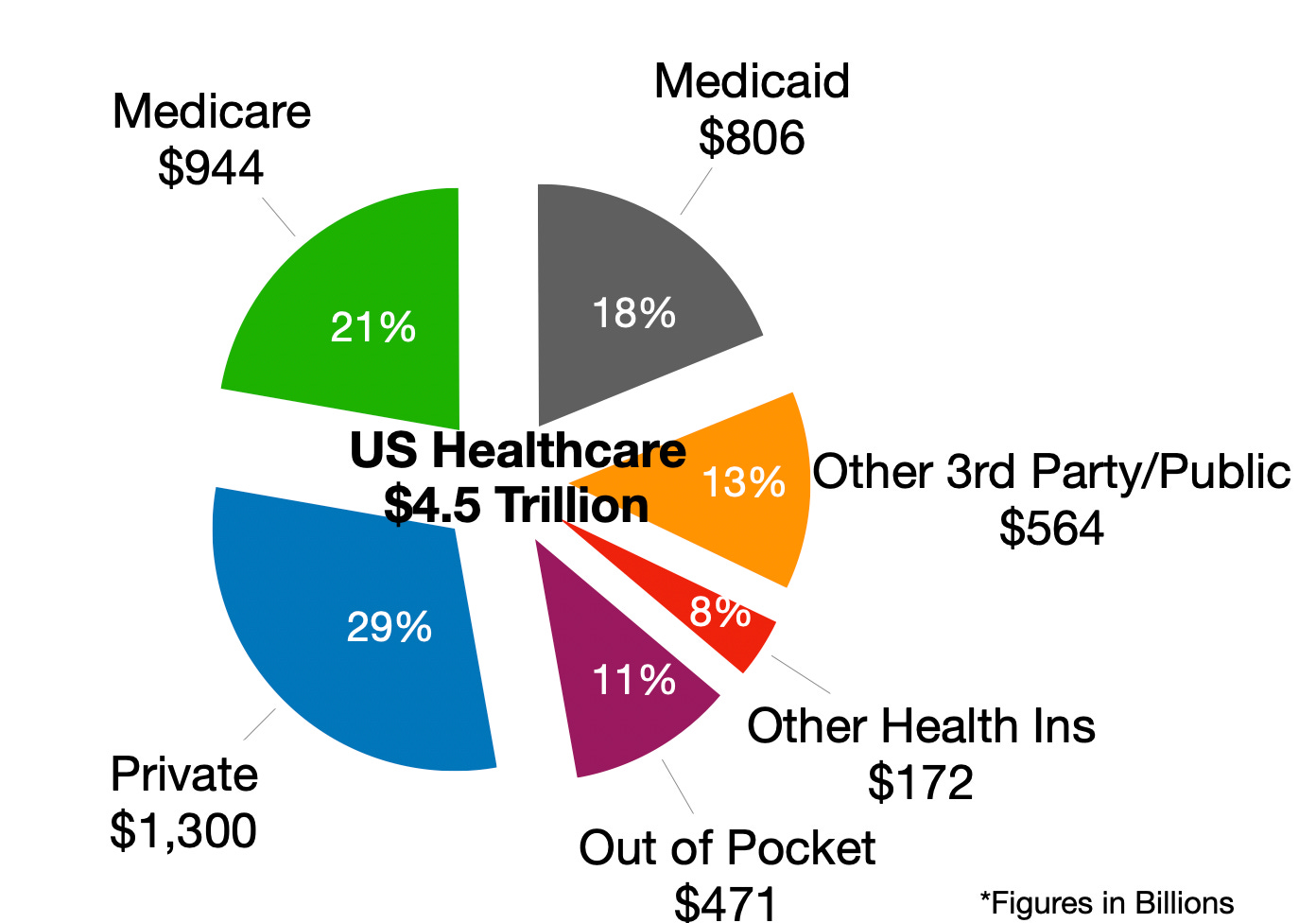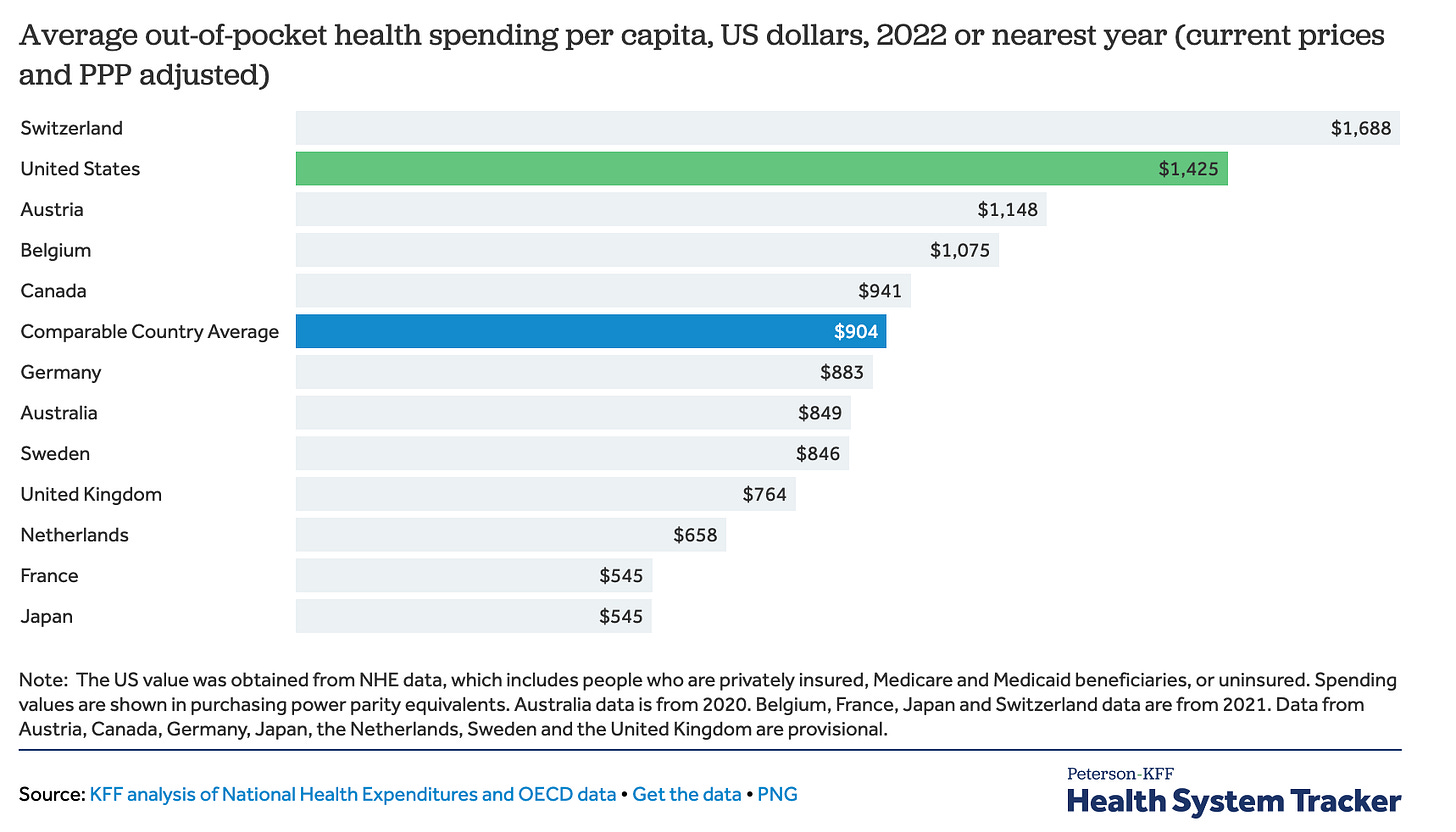Now, we just have to get the next angry young man to both unplug and also, idk, start a protest movement or run for office or do literally anything other than pick up a gun. - Garbage Day
This week:
Healthcare
Good Trouble For America
You can hold two competing thoughts in your head. Murder is wrong. But also, so is our healthcare system.
The murder of an insurance company CEO this week sparked a massive amount of interest in the manhunt as well as a lot of schadenfreude for an industry executive getting his just desserts; and ‘pearl-clutching’ over both the act of violence as well as the widespread celebration.
The whole story is an incredible microcosm of the state of the country. Mixing class, inequality, healthcare, the surveillance state, and guns with an overall dissatisfaction with the state of the country and its institutions.
For Healthcare in America
One thing the shooting made clear. What unites us all is an outrage over our healthcare system. And rightfully, for what we spend one has to wonder what we’re getting back.
Collectively in the U.S., we spend $4.5 trillion on healthcare, or 17.3 percent of the national Gross Domestic Product.
That works out to $13,493 per person, or roughly double what someone spends in comparable OECD countries to ours.
Now one would assume that with this extra spending we enjoy better results, yet it’s quite the opposite:
Life expectancy in the US is three years lower than the OECD average
The rate of Avoidable deaths per 100K (aka treatable) is nearly 2x that of most OECD countries
The US leads in rates of obesity, infant and maternal deaths (prior to Dobbs mind you), and the likelihood of having multiple chronic conditions
Doesn’t insurance cover all of this? Not quite.
Of the $4.5 trillion spent on healthcare in the U.S. as of ‘22:
Leaving the remaining 11 percent covered by Out-of-pocket ($471B).
That works out to about $1,425 per person annually, or 57% above the OECD country average; trailing only Switzerland.
One would assume having insurance would cover you, however, that’s not necessarily true either.
18% of insured US adults reported having coverage denied in the past year (when they thought it was covered)
For those who get their insurance through their employer that percentage goes up (21%)
Likewise, the more you access your coverage the more likely you are to encounter denials
27% of frequent visitors (10+ annually) reporting denials
Compared to 14% of low visitors (3 or less)
About one in five insured adults who used emergency room services (22%) or mental health services (22%) say they had a denied claim
Many Americans (1 in 4) forgo or delay necessary care to avoid medical costs, and that number jumps to 6 in 10 if you’re uninsured.
Luigi’s popularity is communal grief masked as humor and lust. We need victories and heroes so deeply, we’ll settle for a murder and cheer on an unwell young man. We feel so abandoned by this healthcare system—and, by extension, this “great” country. - Leo Herrera
What this spend does bring, is debt:
Americans owe $220 Billion in medical debt
41% of Americans are in some form of medical debt
Approximately 6% (14MM) of adults owe over $1,000 in medical debt
About 1 in 6 have taken out a personal loan to help cover medical debt.
In a country where the average American doesn’t have the savings to cover a $1,000 emergency, a medical emergency is often a killer for both the patient and their family:
66.5% of bankruptcies are caused directly by medical expenses, making it the leading cause for bankruptcy.
Additionally, medical problems that lead to work loss cause 44% of bankruptcies.
17% of adults with health care debt declared bankruptcy or lost their homes because of it.
1 in 4 cancer patients will declare bankruptcy or lose their home to eviction, and another 41% will deplete their life savings.
It’s the Insurance Companies Fault then, right? Not so easy.
Show Me the Incentives I’ll Show the Outcome
As much as the incentives for Insurance companies are to ‘delay, deny and defend’ in order to maximize profitability, providers (ie, hospitals, doctors, drug companies etc) are incentivized to overcharge knowing that insurance is there to cover the cost.
A recent example is the case of Anthem Blue Cross (insurance provider) who “unilaterally declared it will no longer pay for anesthesia care if the surgery or procedure goes beyond an arbitrary time limit, regardless of how long the surgical procedure takes.”
The negative PR writes itself, however, when you peel back a bit they have a case. Studies find Anesthesiologists erring on the side of exaggerating how long their services were required during an operation, leading to overbilling. As such, the average anesthesiologist now earns $472K as of ‘23, a $70K increase YOY, making anesthesiologists among the top five highest-earning specialists in the United States.
This isn’t an anomaly. The average US physcian salary is $352k as of ‘23; compared to $160K in Germany, $122K in the UK or $93K in France.

Anthem’s policy would have forced anesthesiologists to accept a contracted lower rate of pay, one that would force them to accept the reimbursement rules, not pass along the overage to the patient.
“A single death is a tragedy, a million deaths are a statistic,” - Joseph Stalin
We’re in an Abusive Relationship
I’m not sure what could fix the broken healthcare system here (although I believe moving to a single-payer healthcare system would go a long way).
But much of the system we have now relies on confusion.
Half of all insured adults find some aspect of insurance difficult to understand,
Among those who experience claims denials it is nearly 8 in 10.
CMS requires insurers to report the reasons for claims denials at the plan level.
Of in-network claims, about 14% were denied because the claim was for an excluded service,
8% due to lack of preauthorization or referral, and only about 2% based on medical necessity.
Most plan-reported denials (77%) were classified as ‘all other reasons.’
Insurers upheld most (59%) denials on appeal.
Among the 58% of insured adults who had a problem with their insurance in the past year,
about one in six (17%) say they were unable to receive recommended care as a direct result of their problems;
15% say they experienced a decline in their health
and about three in ten (28%) say they paid more than they expected for care all as a direct result of their problems.
Despite this, most insured adults (81%) give their health insurance an overall rating of “excellent” or “good.
We love our insurance even though it doesn’t love us back. If that doesn’t meet the definition of an abusive relationship, I don’t know what does.
Sunlight is the Best Disinfectant
Half Of the Insured Adults Have At Least Some Difficulty Understanding Their Insurance, including what it covers (36%), what they will owe out-of-pocket (31%), and even basic insurance terms (25%).
Knowing why your claim or prior authorization request was denied can be key to submitting an effective appeal, but most people don’t know that they have a right to this information. Few insurers offer instructions or templates on their websites, and even fewer advertise any guidance they do offer.
Thankfully some are stepping in to help out:
ProPublica’s Claim File Helper will you file your claim in an orderly manner. By answering a few questions, the service spits out an appropriate claim file request letter for you to send in.
FairHealth is an independent, national, nonprofit organization with a mission to help you understand your healthcare costs and health coverage. Their site and apps can help provide useful estimates based on over 2B claims it receives each year from health insurers.
Similarly, ClearHealthCosts is a journalism company reporting on healthcare costs to bring transparency to the system. Reporting out to share with other newsrooms so people can become informed.
Related:
Also,from Vox Luigi Mangione’s 3D-printed gun and the problem of untraceable firearms
So-called ‘ghost guns’ - a gun that is essentially homemade and often lacks a serial number like the ones required on guns sold by major manufacturers - are usually harder to trace. They’re also becoming more frequently used in crimes.
Gifting
You may not be as
Here’s how to give a good gift, according to science people often give gifts that satisfy their own desires — for uniqueness, societal approval or as a gag — rather than the desires of recipients
About 17% of all goods sold, end up being returned. Retail returns: An $890 billion problem
66% have stayed up the entire night in a bid to get everything ready. The Lengths Parents Will Go to Make Holidays Memorable For Their Kids: Poll
Libertarianism: Your mum does the washing. You believe you did the washing.
Other Headlines
Enron is “back”, actually it’s new “CEO” is the man behind “Birds Aren’t Real’ and is using the infamous company as a true satirical version of corporate American greed. For example:
Enron CEO calls on followers to support killed health care executive in latest satirical jab
And 'Enron CEO' Hit With A Pie In The Face In New York | VIDEO bringing back memories of Bill Gates pie facesmack back when he was Microsoft CEO
Getting a college degree isn’t quite the slamdunk it used to be. The unemployment rate for recent grads ticked up to 5.3 percent, while the underemployment rate held steady at around 40.6 percent.
This is the most expensive property currently for sale in the US… and destined to be flooded (not surprisingly, in Florida)
Asleep at the Wheel in the Headlight Brightness Wars, Reddit’s r/FuckYourHeadlights is on a crusade to dim car headlights which have doubled in brightness since ‘15
TVs don’t actually cost 98% less than they used to... and other inflation misconceptions One of the biggest disconnects between what economists care about (the bleeding edge of the latest monthly data) and what normal people care about (is my grocery bill more this week than I remember it used to be?) is a simple issue of measurement.
Does YouTube have a future if its creators have to make most of their money elsewhere?
In a Test of Adult Know-How, America Comes Up Short The least-educated workers are falling behind on basic skills such as reading a thermometer and planning a trip
57% of Americans surveyed would rather live in a larger house, even if it meant schools, stores, and restaurants were several miles away
Building ‘15-minute cities’ would help fix both housing and climate issues. So Why do so many Americans prefer sprawl to walkable neighborhoods?
A study over a 30-year period finds we’re walking 15% faster while also spending half the time lingering in these spaces. Urban residents increasingly view streets as thoroughfares rather than as social spaces, which has important implications for the role of public spaces in fostering social engagement.
How Bob Dylan, Housing Prices, and Harvard show that Networks Matter Cities, like colleges, are networks or rather places to network and thus offer better opportunities to get ahead. But like colleges, the price of living in these ‘networks’ is driving those who could most benefit away.
The new rules of media: 20 lessons for digital media’s present and future
AI Stuff
Lawsuit: A chatbot hinted a kid should kill his parents over screen time limits
AI infiltrates the rat world: New robot can interact socially with real lab rats
From Popular Science The 50 greatest innovations of 2024
Wearing a seat belt adds additional discomfort for the 100,000 or so people every year in America who undergo a mastectomy. Ford’s free accessory the SupportBelt, a contoured pad that attaches to a standard seat belt to relieve pressure and tenderness around the chest.
The Joule Hive firebricks use clean electricity to maintain temperatures as high as 3,270 degrees Fahrenheit in a shipping container-sized box full of hot ceramic bricks. One Stanford study found that if deployed widely worldwide, firebricks could eliminate 90% of the fossil fuels heavy industry burns for heat.
Applied Carbon developed a way to turn the prodigious waste left in fields after corn, wheat and sugar harvests; turning the not very dense materials into biochar which could sequester roughly 2 billions tons of CO2 each year.
Climax became the first ever vegan cheesemaker to win a prestigious Good Food award—though dairy complaints caused the prize to be rescinded at the last minute.
Starting in 2025, several states including New York and California will ban the sale of PFAS in apparel. Patagonia’s built-from-the-ground-up M10 collection’s waterproof membrane borrows from the car battery industry, using mechanically made nanoporous membranes to separate ions.
Famous Campaigns Top 50 creative brand marketing campaigns of 2024
I'm not that much of a socialist compared to Eisenhower. - Bernie Sanders










